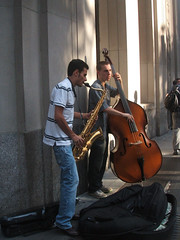Key ingredients for a successful "social town center"

Posted February 11, 2011 at 1:29PM
If some of the traditional functions of town centers, like shopping and office concentrations, are diminishing due to technology and economic changes, can they still have a purpose? That is the intriguing question posed by British urbanist Julian Dobson in a provocative essay titled “From Ghost Town to Host Town,” published first by his consultancy, Urban Pollinators, and condensed in a post on the Sustainable Cities Collective site. (Sustainable Cities syndicates work from a roster of writers, occasionally including yours truly.)
In the longer version, Dobson posits that “planning policies that favored town center developments [based on retail] masked three problems: the UK has more retail space than it needs; the nature of retail is changing fundamentally as an increasing proportion of business is done online; and the debt-fuelled rise in personal disposable income has ground to a halt.” Those problems are not, of course, limited to the UK, and I would add that telecommuting and corporate downsizing (sometimes in space even when not in people) are also changing demand for traditional downtown functions. Not to mention a half-century of unchecked sprawl.
But the changing nature of retail is Dobson’s main point, and he observes that, especially in smaller towns and neighborhood shopping centers, stores are continuing to close. “Nostalgia and middle-class spending power won’t save our town centers,” he writes. So, if you care about places, what to do? Acknowledge that there are other reasons, more relevant to the 21st century, for town centers:
“
The real challenge will be to turn towns into social centers that support a very wide range of overlapping activities, only some of which are to do with shopping. That means making town centers places for everyone and finding ways to make the various activities they engage in mutually supportive.” (Emphasis mine.)
Such as? Dobson offers seven “pillars” of a social town center:
- A living town center. “Town centers need to be promoted as places to live for a wide mix of people.”
- A learning town center. This might “combine formal learning accredited by universities and colleges with spaces for informal learning and exchanges of skills.”
- A greener town center. “Interest in local growing projects is rising as consumers become more aware of the waste associated with global food distribution systems, and climate change is likely to increase the need for local food resources and for the relearning of gardening skills.”
 A creative town centre. “Creative activities will draw people into urban spaces, generating interaction and business opportunities. Many such activities need temporary, flexible space rather than permanent buildings.”
A creative town centre. “Creative activities will draw people into urban spaces, generating interaction and business opportunities. Many such activities need temporary, flexible space rather than permanent buildings.”- A networked town center. “The key to a successful center is not the buildings or the retail offer; it is the people. People attract other people.”
- Social supply chains. “Town centers that support networking and creativity make good business sense. There is an opportunity to recreate the kind of networks that enabled market towns to succeed in the past - the personal relationships between suppliers, links between producers and consumers.”
- Planned fluidity. Town centers . . . need to be planned for shifting modes of transport, flexible public space, and changes of use that are likely to become more frequent than the planning system currently allows.”
So there you have it. Personally, I have seen too many successful revitalization efforts to give up on traditional downtown functions, and I’m not entirely sure that Dobson’s alternatives are strong enough to replace them in any event. But there’s more than a touch of Richard Florida’s creative class thinking in what Dobson writes, and I think his ideas certainly provide food for thought, and for bearing in mind as we address long-range planning opportunities in towns and cities. Numbers 1, 4 and 7 especially make sense to me.
There is more detail and fleshing out in Dobson’s own writing, of course. If this whets your appetite (forgive two food metaphors in a row, OK?), here are links to the Sustainable Cities post, the post on Dobson’s own blog, and the longer essay in his firm’s newsletter.
Move your cursor over the images for credit information.
